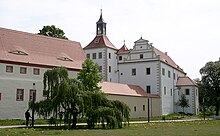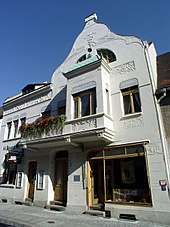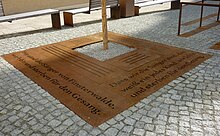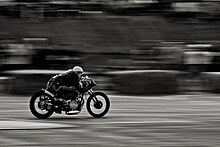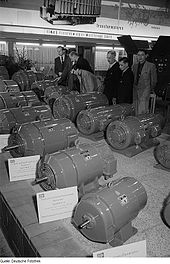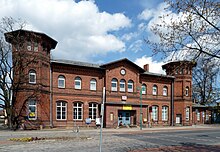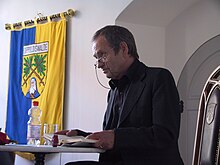Finsterwalde
| coat of arms | Germany map | |
|---|---|---|

|
Coordinates: 51 ° 38 ' N , 13 ° 43' E |
|
| Basic data | ||
| State : | Brandenburg | |
| County : | Elbe Elster | |
| Height : | 108 m above sea level NHN | |
| Area : | 77.2 km 2 | |
| Residents: | 16,068 (Dec. 31, 2019) | |
| Population density : | 208 inhabitants per km 2 | |
| Postal code : | 03238 | |
| Area code : | 03531 | |
| License plate : | EE, FI, LIB | |
| Community key : | 12 0 62 140 | |
| City structure: | 3 districts and 2 districts | |
City administration address : |
Schlossstrasse 7/8 03238 Finsterwalde |
|
| Website : | ||
| Mayor : | Jörg Gampe ( CDU ) | |
| Location of the town of Finsterwalde in the Elbe-Elster district | ||
Finsterwalde ( Lower Sorbian Grabin ) is a town in southern Brandenburg and the most populous place in the Elbe-Elster district . From 1952 to 1993 it was the seat of the district or district of Finsterwalde .
The hit of the late 19th century "We are the singers of Finsterwalde" and the Finsterwalder Singing Festival named after this title also made the city known nationwide. In official correspondence, the additional designation “ Singer City ” has therefore also been used since 2009 . Since May 16, 2013, with the approval of the Brandenburg Ministry of the Interior, the city has officially used this additional designation, also on the entrance signs.
geography
The city is located in Niederlausitz , a region that is largely in the south of Brandenburg . Finsterwalde is 112 km south of Berlin , 78 km north of Dresden , 53 km southwest of Cottbus and 109 km northeast of Leipzig .
Neighboring communities
The city of Finsterwalde borders on the following municipalities and cities:
| Doberlug-Kirchhain | Sonnewalde | Mass Lower Lusatia |
| Heathland |

|
Lichterfeld-Schacksdorf |
| Gorden-Staupitz | Lauchhammer |
City structure
The urban area consists of the core town of Finsterwalde and the districts
- Pechhütte ( Lower Sorbian : Smólnica ) - 174 inhabitants
- Sorno (Lower Sorbian: Žarnow ) - 428 inhabitants
(Population figures from February 29, 2016 according to the city administration)
as well as the residential areas Heinrichsruh, Hintermühle , Margarethenhof, Nehesdorf , Schiemenzmühle and Zollhaus.
history
The first documentary mention was made in 1282 under the name Vynsterwalde . In 1301, for the first time, a document speaks of a town or at least a settlement in the immediate vicinity of the fortified complex ( oppidum et castrum ). Oppidum here probably only means market town. The unambiguous designation of Finsterwalde as a city only offers a document from the year 1336. In this year the city also got its market rights (city rights).
In its original structure, Finsterwalde represents a typical east Elbe colonist town. Streets that meet at right angles form square quarters that are grouped around the relatively large market square. The settlement area (approx. 11 hectares) had no city wall, but palisades and a city moat and two (or three) city gates, the appearance of which has not been passed down.
The inhabitants of the city were originally primarily farmers . The city's location on important trade routes from Leipzig via Torgau and Spremberg to Breslau (Niedere Straße) and the junction of the Salzstraße to Jüterbog and Niemegk certainly allowed some citizens to participate in trade transactions.
A wooden fortress, presumably built by Slavs, was expanded over time into a fortified castle, which was inhabited by robber barons until the middle of the 15th century and was converted into a castle complex, Finsterwalde Castle , by the new owners from 1437 .
Various trades developed in the city from the late Middle Ages. The commercial manufacture of cloth became the most important branch of the economy. In 1555 Finsterwalder Tuch was represented for the first time at the Leipzig Fair . In 1599 the plague claimed 400 lives. In 1625 Finsterwalde came into the direct possession of the Saxon Elector Johann Georg I. The palace only served as the official residence of the electoral and from 1652 to 1738 the Saxon-Merseburg authorities. In 1642, marauding troops looted the city and castle in the late phase of the Thirty Years' War . The urban industry and community lay now for decades.
The town hall was destroyed in a major fire in 1675. It was not until 1739 that the citizens were able to erect a new building. The simple baroque building still dominates the market square today. In 1815 Finsterwalde came to the Kingdom of Prussia as a result of the Congress of Vienna .
The general industrial boom in the 19th century can be traced back to Finsterwalde almost perfectly. Again, it was cloth production that had a lasting impact on the city's economic development. A few but efficient cloth factories developed from the small guild craft businesses. The most important company in the branch was F. F. Koswigs Tuchfabrik, whose number of employees rose from 3 workers in 1838 to 760 workers and employees in 1913. In addition to cloth manufacturing, companies in the metal, wood, glass, tobacco, chemical and later electrical machine industries developed. The connection to the railway network was completed in 1871 with the construction of the Halle-Sorau railway line .
The population of Finsterwald rose from 1,600 in 1800 to 10,726 in 1900. The city now expanded beyond the medieval settlement area. Newly created residential and commercial areas are like a belt around the original core of the city. Buildings of economic and communal life, which still shape the cityscape today, were erected up to the First World War: the girls' school (1868), the district court (1885), the secondary school (1905), the Catholic Church of St. Maria Mater Dolorosa (1906) , the hospital (1908), the water tower (1909/1910), the boys' school (1913) and the post office (1915). On January 1, 1925, the place Nehesdorf was incorporated into the city of Finsterwalde.
During the Second World War , 963 prisoners of war and 2,755 men and women from the countries occupied by Germany had to do forced labor : in the company Kjellberg Electrodes and Machines GmbH , in Reichelt Metall-Schrauben AG and in the cloth works . They were housed in several camps, including the Siemens camp . 392 fatalities were registered among the forced laborers in large companies.
Between 1945 and 1950, at least 685 people were arrested by the Soviet NKVD's secret police in the Finsterwalde district . Around 250 people were killed in the Soviet special camps or military prisons.
During the GDR era, Finsterwalde was known as a city for cyclists. On January 1, 1988, the district was the devastated town Bergheide incorporated into the city. On December 6, 1993, the place Sorno followed, which is now a district of Finsterwalde.
Today Finsterwalde is an important business location in western Lower Lusatia. But its reputation as a factory town, which still has the image of sooty chimneys, has been replaced by Finsterwald's reputation as a town of singers. The reason for this is not primarily in the long tradition of local singing, but mainly in the fact that a song, a hit song, which Finsterwalder names as particularly happy to sing.
In 1899, the director of Mr. Singer Company "Hamburger singer" asked Wilhelm Wolff in the political police Berlin to the performance license of his little play "We are the singers of Finsterwalde". In the splendid Germania halls on Berlin's Chausseestrasse , the Wolffsche Gesellschaft performed the burlesque that was entirely in keeping with the taste of the entertainment business at the turn of the century. The premiere took place there on September 3, 1899. Here the singers, three strikingly dressed men with the characteristic names Pampel, Knarrig and Strippe, appeared for the first time with their entree song "We are the singers from Finsterwalde". At the beginning of the singer mania, the citizens of the city were not at all pleased to be compared with the mostly comical or even wine-blissful figures in tails and top hats. But finally humor won, because otherwise the real Finsterwalder would have run the risk of falling into ridicule. The song by the singers from Finsterwalde became a catchy tune and could be heard everywhere. The people of Finsterwalder still like to sing their song and the song variants based on it, which have been created up to the present day. In contrast to the original line-up, the Finsterwalder singers now play four people. “We are the singers from Finsterwalde” is still the opening song of the biennial singing festival.
The city belonged to the district of Luckau from 1817–1952 (until 1947 in the Prussian province of Brandenburg , 1947–1952 in the state of Brandenburg ). 1952-1993 was Finsterwalde county seat of the same district (until 1990 in East Germany - Cottbus district , 1990-1993 again in Brandenburg). Since the district reform in 1993 , the city has been in the Elbe-Elster district.
Population development
|
|
|
|
Territory of the respective year, from 1991 on 31.12., Population from 2011 based on the 2011 census
politics
City Council
The Finsterwalder city council consists of 28 city councilors and the full-time mayor.
| Party / group of voters | Seats |
|---|---|
| CDU | 9 |
| Citizens for Finsterwalde (BfF) | 4th |
| Independent citizens of Finsterwalde (UBF) | 4th |
| AfD | 4th |
| The left | 3 |
| SPD | 3 |
| Alliance 90 / The Greens | 1 |
(As of: local election on May 26, 2019 )
mayor
- 1990–2010: Johannes Wohmann (FDP)
- since 2010: Jörg Gampe (CDU)
In the mayoral election on September 24, 2017, Gampe was confirmed in office for a further eight years with 65.6% of the valid votes.
coat of arms
The coat of arms was approved on January 6, 1994.
Blazon : “In silver, a continuous red battlement wall, on top of it a square red round tower with a kneaded blue dome and two black windows standing one above the other. The open black gate has a raised silver portcullis. A green leafy tree grows up on the green ground in front of the wall on either side of the tower and the gate. "
Town twinning
Since 1962 there has been a town partnership with the northern French town of Montataire . Finsterwalde also maintains a partnership with Eppelborn in Saarland. The partnership certificate was signed on May 13, 1988 in Finsterwalde and on July 1, 1988 in Eppelborn. After the reunification of Germany, the treaty was renewed in 1991 and 1992 respectively. The third twin city is Finspång in Sweden. The contract was signed on March 21, 2002. Streets were named after Montataire, Eppelborn, Finspång and Salaspils (Rue de Montataire, Eppelborner Ecke, Finspangsgatan, Salaspils iela).
Partnership relationships are maintained with the following cities:
- Sønderborg (Denmark)
- Gouda (Netherlands)
- Dzierzgoń (Poland)
- Salaspils (Latvia)
Sights and culture
The list of architectural monuments in Finsterwalde and the list of ground monuments in Finsterwalde contain the cultural monuments entered in the monuments list of the State of Brandenburg.
Buildings
Trinity Church
As a three-aisled gallery church, the Trinity Church was built at the end of the 16th century on the site of a previous building under the direction of Martin Piger. On the north side it received a magnificent Renaissance gable. The interior is well worth seeing, especially because of the beautiful ribbed vault and the sandstone pulpit, which Melchior Kunze created between 1613 and 1615. Here you can see Moses as the figure carrying the pulpit and scenic reliefs.
Merchant's house Ad. Bauer's Wwe.
The son of the merchant 's wife Marie Bauer had the residential and commercial building built in 1903. It is one of the most beautiful Art Nouveau houses in Finsterwalde. The two-story eaves house can already be seen from afar due to its high gable top. The bay window with its copper cladding and the balcony shape the appearance of the listed building. The white facade lives from its rich plaster design, which shows the production of grain in the eaves area and the rod of Mercury in the gable.
- Finsterwalde Castle (Renaissance)
- Curtsburg (before 1572), probably the oldest residential building in the city
- Town hall (1739), baroque building on the market, rebuilt and restored 1927–1928
- Gasworks (1863), one of the few preserved half-timbered houses
- Realschule (1905), brick building with stained glass on the outside windows
- Roman Catholic Church of St. Maria Mater Dolorosa (1906)
- Hospital (1905–1908 based on a design by city architect Paul Droste), brick building
- Water tower (1909–1910 based on a design by city architect Paul Droste), a landmark of the city with a height of 54 m
- “Weltspiegel” cinema, purpose-built cinema built in 1912 with a small cinema and large hall with separate parquet, box and vision bar and 3-D presentation.
- Gutenberghaus (1926), former publishing house of the "Niederlausitzer Anzeiger"
- Denominational boys' school (1912–1913 based on a design by Max Taut )
- Märchenhaus (1928–1929 based on a design by the architect Dassel), with 27 artistic clinker brick reliefs depicting scenes from well-known fairy tales by the Brothers Grimm
- Double gym (1928 based on a design by Kurt Vogeler), construction with two gyms built on top of each other
- Tower on the airfield site, a combination of tower and administration building that is unique in Germany (listed)
- St. Catherine's Church in Nehesdorf
- Memorials
- Memorial wall at the intersection of Geschwister-Scholl-Straße / Langer Damm; Shortly after the Second World War , it was dedicated to the seven murdered resistance fighters in the city, and in 1996 the dedication was expanded to include “all victims of dictatorship and tyranny and a memorial for democracy and justice”.
- Memorial stone in the cemetery on Beethovenstrasse from 1946 for 230 Soviet prisoners of war who died
- United Nations memorial from 1967 in the cemetery on Beethovenstrasse to commemorate 283 dead forced laborers from numerous countries
- Memorial stone for Hans and Sophie Scholl in Schloßstraße 7 , which continues into Geschwister-Scholl-Straße
- Relief in honor of Vladimir Ilyich Lenin in the Bürgerheide
Museums
The city is home to the Finsterwalde district museum. The centerpiece of this is an original grocery store, which opened in November 1850. The museum offers an insight into an authentically furnished " mom and pop shop " from the 20th century. It was opened in 1981. Some of the sales furniture dates back to the early days, the interior, the packaging and the advertising convey a clear impression of the sales culture of the period after the First World War.
In the adjoining parts of the building there is also a replica of the GDR drugstore and a department with sales utensils, which complements the retail presentation. In addition to the "Finsterwalder Singers", other permanent exhibitions deal with the history of the choir in the southern Brandenburg / Saxon region. A small exhibition on the natural history of the region is aimed particularly at children and young people. In the museum courtyard and the adjoining "Speicher" there are constantly changing special exhibitions as well as cultural and musical events of all kinds.
Since 2002 the Niederlausitzer Museumseisenbahn has been offering a further attraction for the city and its guests: On the standard-gauge track section between Finsterwalde and Crinitz , which was closed many years ago , the non-profit association Niederlausitzer Museumseisenbahn e. V. Finsterwalde-Crinitz (NLME eV) to immerse yourself in a different time with the lovingly restored locomotives and wagons, which are mostly over 100 years old.
The Finsterwalder Fire Brigade Museum , which deals with the history of the regional volunteer fire brigade and fire fighting, can be found in the remise of a manufacturer's villa from the 19th century on Geschwister-Scholl-Straße .
Finsterwalder Bürgerheide
The Bürgerheide in the west of the city is initially a city park and turns into a forest area, which not only invites you to relax and hike, but is also very popular with athletes as a jogging area. According to tradition, the former mayor of Finsterwalde, Abraham Koswig, is said to have "owned" what is today the local recreation area in Finsterwalder in 1661 through a beer bet. Allegedly, he won the bet by emptying a glass of beer with a mouse swimming in it.
As part of the Bürgerheide, the Finsterwalder Tierpark is an attraction, especially for families with children. About 200 animals from eagle owls to dwarf goats, llamas and lynxes to kangaroos are kept on a size of 5 hectares. In addition to native animals, animals from distant countries also live in the Finsterwalder Tierpark. The breeding of native animal species serves to preserve the species.
On the western edge of the Bürgerheide there is a source area, the Siebenbrunnen, from which the egg player feeds. This spring bog is one of the best preserved bogs in Brandenburg and its hydrological properties are unique in the state.
Regular events
Finsterwalder Singing Festival
The Finsterwalder Singing Festival takes place every two years . Performances by bands, bands and music artists from Germany, Europe and America take place on numerous stages in the city center. In April 1992 the “Finsterwalder-Singer-Fest e. V. ”, who has been responsible for the planning and implementation of the singer festival idea ever since. The song festival, with guests from home and abroad, is one of the largest folk festivals in Brandenburg. The three-day event will end with a parade through the city.
Headbanging old-style 1/8 mile racing
Since 2000, one of the largest hot rod races in Germany (1/8 mile races) has been taking place on the runway of the old military airfield in Finsterwalde / Schacksdorf on the first weekend in September . Admission is for vehicles built before 1958. Cars and motorcycles can take part in these races. The organizers are the Hot Heads East, a Hot Rod Club from Finsterwalde.
Finsterwalder town talks
The old warehouse of the merchant house “Ad. Bauer's Wwe. ” Has served as the venue for the Finsterwalder City Talks since 2000 and has thus found a permanent place in the city's cultural life. The participants include personalities from politics, culture and science. The aim of the loose lecture series is, based on a lecture or a reading about the past, current or future, to get into an informal conversation among and with the audience. The old warehouse forms a unique backdrop in its own surprising surroundings.
Finsterwalder Chamber Music Festival ...
The Finsterwalder Chamber Music Festival has been taking place since 2012.
Sparkassen Summer Open Air
Every two years between the singer festival years on the Finsterwalde market square.
Finsterwalder zoo festival
yearly
Finsterwalder Christmas market
Friday to Sunday every year on the 3rd weekend in Advent.
Economy and Infrastructure
Middle center
In the Berlin-Brandenburg state development plan of March 31, 2009, Finsterwalde was defined as its own medium-sized center. The other two centers, Herzberg (Elster) and Elsterwerda , Bad Liebenwerda, with a division of functions, are in the list of upper and medium-sized centers in Brandenburg .
Growth core of the metal and electrical industry
In and around Finsterwalde there are primarily companies in the metal and electrical industries. The Kjellberg Finsterwalde group of companies has been manufacturing welding machines , welding electrodes and, with growing success, plasma cutting technology (2004: market leader in Europe). Other large companies in this region are the Drahtwerk (since 2007: voestalpine Wire Germany GmbH ), the screw factory, the Finsterwalder Maschinen- und Anlagenbau GmbH (FIMAG) and the Industriegalvanik GmbH ( GALFA Industriegalvanik ).
In total, the companies in the sector employ around 1,500 people. Finsterwalde is thus the center of the metal and electrical industry in southern Brandenburg.
Most of the companies are now anchored in a stable network that has established itself in southern Brandenburg, northern Saxony and eastern Saxony-Anhalt and, as ARGE Metall- und Elektroindustrie Südbrandenburg, represents a decentralized cluster approach.
Finsterwalde is a member of the growth core West Lusatia .
With the Finsterwalde solar park in the area of the former Kleinleipisch open- cast lignite mine , the third largest photovoltaic system in Germany with a nominal output of 41 megawatts was built, which, with two further expansion stages, reaches 80 megawatts. The project developer is the German company Q-Cells. A Chinese company became the majority shareholder through complicated market-economy mechanisms and the modules are contractually bound until 2018, mainly from the People's Republic of China , which thus benefits considerably from the high German subsidies in the solar industry.
traffic
Road traffic
The B 96 between Luckau and Senftenberg , the state road L 60 between Doberlug-Kirchhain and Lauchhammer and the L 62 to Elsterwerda lead through Finsterwalde . The Bronkow and Großräschen junctions on the A 13 ( Berlin - Dresden ) are 17 km and 18 km away, respectively.
Rail transport
The station Finsterwalde was during the route construction by the Halle-Sorau Gubener railway- built and is now a station of the electrified rail link from Leipzig / Halle to Cottbus . The regional express line RE 10 Leipzig - Cottbus and the regional train line RB 43 Falkenberg (Elster) - Cottbus stop there .
From here the lines branched off to Crinitz – Luckau (closed in 1968) and to Schipkau (closed in 1967). The latter was operated by the Schipkau-Finsterwalder Railway until 1949 . Another connection existed until 2006 with the nearby town of Großräschen .
Local public transport
Public transport ( public transport ) operate buses transport Elbe-Elster GmbH from Finsterwalde.
Air traffic
On the western outskirts of Finsterwalde is the Finsterwalde-Heinrichsruh special airfield (ICAO code: EDAS), popularly known as the “glider airfield” in Finsterwalde. The airfield has a grass runway with a length of 980 m. The aviation association “Otto Lilienthal” e. V. the airfield, which was closed in 1979. Flight festivals, which are very popular, take place here regularly. The authorization to drive a glider can be acquired here in the association.
On the southern outskirts of Finsterwalde there is the special landing site "Lausitz-Flugplatz" (ICAO code: EDUS; GPS coordinates: 51 ° 36 '27 " N , 13 ° 44' 17" E ). It has two runways (a concrete runway, 1,200 m long (2,470 m before the renovation in the 1990s), 30 m wide, approved up to 14,000 kg MTOM and a grass runway, 885 m long, 40 m wide, approved up to 2,000 kg MTOM) and is popularly known as the “Russenflugplatz” in Finsterwald. During the GDR era, the area was under the Soviet military and MiGs took off three days a week for control and training flights. The hot rod race will take place on the runway on the first weekend in September .
education
In Finsterwalde there is the Sängerstadt-Gymnasium , a secondary school , a general special school and three elementary schools as well as an upper school center , a district adult education center and a regional office of the district music school " Gebrüder Graun ".
Until mid-2006 Finsterwalde had two grammar schools. The Janusz-Korczak-Gymnasium was maintained next to the Singing City Gymnasium . Its building has belonged to the Sängerstadt-Gymnasium since the 2006 summer vacation. The comprehensive school and the secondary school were also merged into one high school.
Sports
- RSV Finsterwalde (cycling)
- AMC Sängerstadt Finsterwalde IG (car model racing)
- BSV Grün-Weiß Finsterwalde e. V. (handball, archers, gymnastics, cheerleaders, volleyball)
- VfB Finsterwalde e. V. (formerly SV ESKA Finsterwalde e.V.) (football, volleyball, gymnastics, running group, until 2004 also handball)
- Aviation Association Otto Lilienthal e. V.
- VSG Fortuna Taifuns Finsterwalde e. V. (volleyball)
- SV Hertha Finsterwalde (soccer, bike ball, bowling)
- DJK Finsterwalde (football, volleyball, gymnastics)
- FC Sängerstadt Finsterwalde (merger of the football departments SV Hertha Finsterwalde and DJK Finsterwalde)
- SV Neptun Finsterwalde 08 e. V. (basketball, triathlon, water polo, swimming, volleyball, soccer, weight training, kombatan, running group, gymnastics, jazz dance, water watch)
- SV Finsterwalde e. V. (cycling)
- SpVgg Finsterwalde e. V. (football)
- TC-Singer City Finsterwalde e. V. (tennis)
- SV Turbine Finsterwalde (Classic cones)
- TTC Finsterwalde (table tennis)
- ASC Grün-Weiß Finsterwalde (athletics)
- Badminton club "Singer City" Finsterwalde e. V.
- DarkwoodBmx e. V.
- Judo / Ju-Jutsu association "IPPON" Kirchhain / Finsterwalde e. V.
Personalities
sons and daughters of the town
- Pancraz Krüger (1546–1614), humanist and educator
- Christoph Lehmann (1568–1638), writer and town clerk in Speyer
- Louis Schiller (1839–1917), teacher, committed citizen of the city, namesake of the Louis Schiller Medal
- Hermann Kotzschmar (1829–1908), musician and composer
- Willibald Faber (1873–1946), politician (NSDAP)
- Otto Ostrowski (1883–1963), Mayor of Finsterwalde in the 1920s (SPD)
- Georg Geist (1895–1974), Mayor of Finsterwalde 1926–1933
- Johannes Hennings (1900–1973), politician (GB / BHE)
- Michael Münster (1901–1986), politician (NSDAP), member of the Reichstag
- Hans Richter (1905–1962), politician (NSDAP)
- Walter Schultze (1907–1976), manufacturer and entrepreneur, inventor of induction heating systems
- Inge Deutschkron (* 1922), journalist and author
- Richard Meininger (Ball-Ricco) (1925–2009), clown
- Evelyn Hartnick-Geismeier (1931–2017), sculptor and medalist
- Wilfried Schwarz (* 1937), painter and teacher
- Lothar Schmidt-Mühlisch (1938–2007), journalist and writer
- Gottfried Mai (* 1940), naval pastor and author
- Peter Ensikat (1941–2013), writer and cabaret artist
- Diethard Haas (* 1942), politician (CDU), 1990–1993 District Administrator of the Finsterwalde district
- Peter Aufgebauer (* 1948), historian
- Bernd-Erwin Schramm (* 1948), 2008–2015 Lord Mayor of Freiberg
- Peter Drenske (* 1960), politician (AfD)
- Stephan Steinlein (* 1961), diplomat of the GDR and FRG, last GDR ambassador to France
- Catrin Große (* 1964), painter, graphic artist and sculptor
- Dirk Schoedon (* 1964), actor
- Mario Schröder (* 1965), dancer and choreographer
- Andreas Schulze (* 1972), writer and musician
- Julia-Maria Köhler (* 1978), actress
including athletes
- Helfried Wunderlich (1930–1969), badminton player
- Peter Weber (* 1938), apparatus gymnast
- Rainer Hanschke (* 1951), gymnast
- Hans-Jürgen Riediger (* 1955), football player
- Klaus Skobowsky (* 1958), badminton player
- Christine Maertin (* 1960), badminton player
- Carmen Prinz (* 1960), badminton player
- Detlef Irrgang (* 1966), soccer player
- Andrea Pohling (* 1966), badminton player
- Silvio Warsönke (* 1967), track and field athlete
- Petra Schubert (* 1968), badminton player
- Peggy Richter (* 1973), badminton player
- Sonja Kesselschläger (* 1978), track and field athlete
- Stephanie Pohl (* 1978), beach volleyball player
- Henning Bommel (* 1983), racing cyclist
- Peggy Nietgen (* 1986), soccer player
- Enrico Martini (* 1988), football player
- Franz Löschke (* 1989), triathlete
- Charlott Arndt (* 1992), track cyclist
- Thomas Eisfeld (* 1993), soccer player
- Georg Pöhle (* 1994), handball player
- Nik Schröter (* 1998), track cyclist
- Moritz Broschinski (* 2000), soccer player
literature
- Rainer Ernst, Olaf Weber: Finsterwalde. A reader on the history of the city. Finsterwalde 1994.
- Wilhelm Gericke, Gottfried Mai: History of the town of Finsterwalde and its singers. Augsburg 1979.
- Heinz Oette: Finsterwalde, a town of singers. A historical review. Horb am Neckar 1992.
- Otto Schlobach: On the history of the city of Finsterwalde. Espenhahn, Finsterwalde 1892. ( digitized version )
- Manfred Woitzik: Genius Loci. Finsterwalder settlement and building history. Association of Friends and Friends of the Finsterwalde District Museum e. V., Finsterwalde 2010, ISBN 978-3-9811107-0-8 .
Web links
- Finsterwalde website
- Website of the singer city marketing e. V. and the tourist information
- Website of the Finsterwalder town talk
- Link catalog on Finsterwalde at curlie.org (formerly DMOZ )
Individual evidence
- ↑ Population in the State of Brandenburg according to municipalities, offices and municipalities not subject to official registration on December 31, 2019 (XLSX file; 223 KB) (updated official population figures) ( help on this ).
- ↑ a b Main statutes of the city of Finsterwalde from February 25, 2009 (PDF)
- ↑ Message from the Brandenburg Ministry of the Interior (PDF)
- ^ City of Finsterwalde . Service portal of the state administration of the state of Brandenburg. City of Finsterwalde
- ↑ a b c Historical municipality directory of the state of Brandenburg 1875 to 2005 , 19.4 Elbe-Elster district (PDF) State enterprise for data processing and statistics of the state of Brandenburg
- ↑ G. Didier: Internees, condemned and deported by the Soviet occupying power in the Finsterwalde area 1945–1950 . (PDF) Documentation in the Finsterwalde District Museum. List of names compiled in 2012; Retrieved February 19, 2014
- ↑ G. Didier: “ You werewolf ...! Who else ...? ” (PDF) Research project of the Finsterwalde District Museum. 1998; Retrieved February 19, 2014
- ↑ Historical municipality directory of the State of Brandenburg 1875 to 2005. Elbe-Elster district (PDF) pp. 14-17
- ↑ Population in the state of Brandenburg from 1991 to 2015 according to independent cities, districts and municipalities , Table 7
- ^ Office for Statistics Berlin-Brandenburg (Ed.): Statistical report AI 7, A II 3, A III 3. Population development and population status in the state of Brandenburg (respective editions of the month of December)
- ^ Result of the local election on May 26, 2019
- ↑ Jörg Gampe on www.cducsu.de
- ↑ Brandenburg Local Election Act, Section 74
- ^ Result of the mayoral election on September 24, 2017
- ↑ Coat of arms information on the service portal of the state administration of Brandenburg
- ↑ https://leninisstillaround.com/2015/04/27/vor-dem-spielplatz/
- ↑ Finsterwalde Zoo on the city's homepage ( Memento of the original from September 29, 2016 in the Internet Archive ) Info: The archive link was inserted automatically and has not yet been checked. Please check the original and archive link according to the instructions and then remove this notice.
- ^ Website of the song festival
- ^ Website of the Finsterwalder City Talks
- ↑ finsterwalder-kammermusik.de
- ↑ Solar market attracts Chinese . In: FAZ , August 18, 2010
- ↑ Biography Louis Schiller on www.finsterwalde.de





